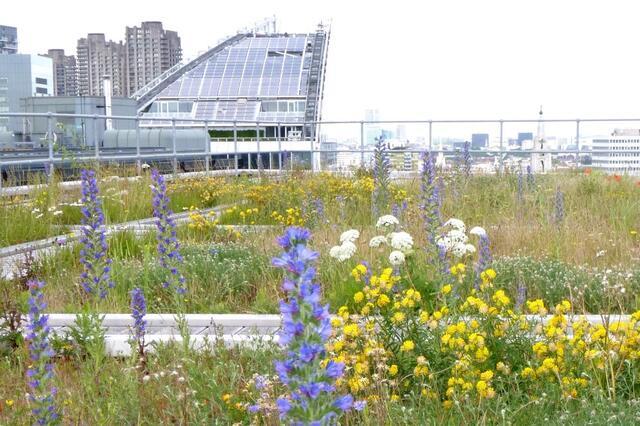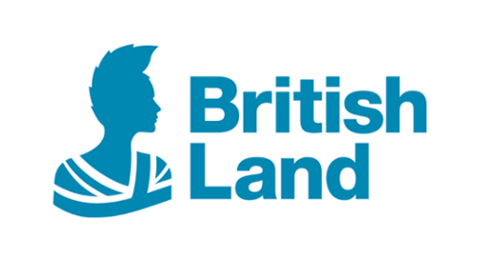Green Roofs in Central London
03 July 2015Green Roofs in Central London
03 July 2015When British Land first included green roofs in its Sustainability Brief for Developments in 2004, the firm needed to work closely with its design partners and property teams to design, plant and maintain habitats that really enhanced biodiversity. Since then, British Land has created green roofs on 12 new buildings in central London, with more under design, and has successfully retrofitted them to three existing buildings.
Key Facts
- 90,000 sq ft of green roof space
- Enhancing urban biodiversity
- Creating pleasant places for people, promoting wellbeing and productivity
- Cutting CO2 emissions
- Reducing local flood risks
- Increasing appeal for occupiers and local authorities
Situation and benefits
British Land is one of the UK’s leading property firms. Green roofs on the company’s central London portfolio not only add biodiversity value to urban areas, they can also:
- Improve the appearance of the roofscape for people on higher floors and in overlooking buildings, transforming areas that might otherwise be unsightly if left bare or filled only with plant equipment
- Create outdoor green spaces for the people who work or live in the buildings, which research has shown can reduce stress and have a positive impact on health, and so enhance wellbeing and productivity
- Reduce local flood risk by slowing rainwater run-off rates through deep substrate levels and rainwater catchment systems
- Cut CO2 emissions from energy use in the building by improving thermal insulation
- Prolong the life of the roof membrane through extra layers of protection, reducing maintenance and replacement costs
- Mitigate the urban heat island effect, removing heat from the air through the natural processes of evaporation and evapotranspiration, cooling the roof surface and the surrounding air
- Support high sustainability ratings such as BREEAM Excellent, a minimum standard for all British Land’s major office developments, increasing appeal for potential occupiers
- Facilitate planning consent, supporting local authorities’ sustainability goals and reducing the risk of surface water flooding in the area.
Actions and financials
British Land has worked with Arup, landscape architects, building managers and occupiers to create 90,000 sq ft of green roof space and terraces at its properties since 2004. The firm’s award-winning approach has been informed by its two-year green roof trial with ecology partner Arup. This identified opportunities to optimise biodiversity, such as laying out different substrates in a mosaic pattern, varying growing media, seed mixes and plant species. Third-party reviews have confirmed the positive biodiversity contributions of British Land’s green roofs, providing shelter and foraging areas for birds, bees, butterflies and other wildlife, and supporting native plant species.
British Land’s green roofs and terraces include:
- 50,000 sq ft at Regent’s Place, which combine attractive outdoor spaces for people based in the buildings, as well as benefits to local biodiversity, providing varied habitats for invertebrate species and foraging habitats for birds including the rare Black Redstart and Peregrine Falcon
- 8,000 sq ft at 201 Bishopsgate and The Broadgate Tower, alongside 1,000 sq ft of green wall, which enhance visual appeal for the surrounding community of office workers, but are not generally accessible and so offer undisturbed areas for wildlife
- 2,000 sq ft of ‘pocket habitats’ retrofitted at Exchange House at Broadgate, with agreement from all occupiers. Within the pockets, different substrates created ecological value from an early stage in the growing process and continue to produce vigorous displays
- 1,300 sq ft at York House, British Land’s Head Office, retrofitted in 2008 and seeded with 30 plant species. This relatively small area of roof, not generally accessible to occupiers, successfully contributes to biodiversity.
Other green roofs under construction by British Land include 5 Broadgate in the City and Marble Arch House in London’s West End. Green roofs in the pipeline on new buildings include those at Clarges in Mayfair, Blossom Street in Shoreditch and 4 Kingdom Street in Paddington Central, as well as significant planting in the Broadgate Circle.
Indicative costs:
- £75 to £100 per sq m for pocket habitats, suitable for retrofit or new developments
- £180 to £260 per sq m for basic sedum roofs to intensive meadow landscapes on new developments.
Challenges and Achievements
ROOF SPACE
How to incorporate green roofs where roof space is at a premium?
In British Land’s experience, it really helps to plan green roof space from early in the design process for new buildings, revisiting it at each stage. Through careful design and early collaboration, even small green roofs can make valuable biodiversity contributions. At 5 Broadgate, green roof space has been set around the plant equipment.
LEARNING
How to maximise biodiversity on green roofs?
Landscape architects and ecologists need to work together to ensure that green roofs encourage biodiversity, at the same time as delivering on aesthetic or amenity requirements. British Land’s lessons learnt include locating varied habitats close together to encourage invertebrates, choosing appropriate plant species and wildflower mixes, particularly those of benefit to invertebrates and other wildlife, and providing nesting boxes in undisturbed locations to encourage birds, bats and invertebrates to take up residence. Monitoring is also important.
BEYOND THE HIVE
How to create effective insect hotels?
British Land and the City of London Corporation challenged architects to design five-star hotels for insects through the Beyond the Hive competition in 2010. Five shortlisted entries were then built across the City of London's public gardens, and British Land commissioned Arup to monitor bug life in these hotels. This revealed that the position of insect hotels is crucial to their success, with those in more diverse habitats showing the greatest activity. As with more mainstream properties, it’s about location, location, location!
Find out more
Sarah Cary
Sustainable Developments Executive
www.britishland.com/sustainability
British Land Green Roof Articles
- http://views.britishland.com/2015/02/green-roofs-go-mainstream/
- http://www.britishland.com/sustainability/stories/2012/biodiversity-takes-root.aspx
- http://www.britishland.com/sustainability/stories/2011/rare-bird-a-regular-visitor-at-regents-place.aspx
- http://www.britishland.com/sustainability/stories/2010/beyond-the-hive.aspx
The Green Roof Code
Green roofs in London
- https://www.cityoflondon.gov.uk/services/environment-and-planning/planning/heritage-and-design/Documents/Green-roof-case-studies-28Nov11.pdf
- https://www.cityoflondon.gov.uk/services/environment-and-planning/planning/design/sustainable-design/Pages/green-roofs.aspx
- http://www.london.gov.uk/priorities/environment/tackling-climate-change/making-london-greener
Photo © Jon Fairey
*Please note that the information on this page was supplied by the BBP Member and the BBP assumes no responsibility or liability for any errors or omissions in the content

